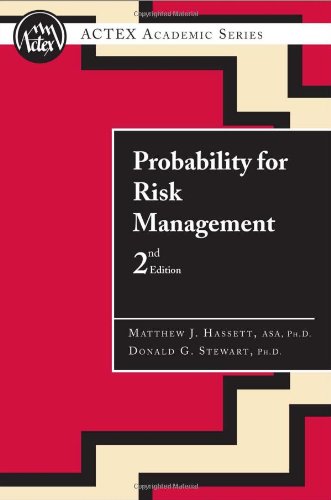Probability for Risk Management ebook download
Par hiltz billie le lundi, novembre 23 2015, 20:16 - Lien permanent
Probability for Risk Management. Donald G. Stewart, Matthew J. Hassett

Probability.for.Risk.Management.pdf
ISBN: 156698548X,9781566985482 | 450 pages | 12 Mb

Probability for Risk Management Donald G. Stewart, Matthew J. Hassett
Publisher: ACTEX Publications
Lastly, try to be aware of the probabilities and the real likelihood of both exceptionally good and exceptionally bad runs. Project risk management is the systematic process of identifying, analyzing, and responding to risk by applying risk management principles and processes at the project level. In this study, a risk assessment model containing four kinds of indexes is provided. Quantitative Risk Assessment for Business Owners 300x227 Quantitative Risk Assessment for Business Owners Risk assessment is the evaluation of probability of hazards in real-life situations in the workplace. The risk management plan should define each of those terms. The accepted way of risk evaluation involves assessing the the extent of impacts and the probability of occurrence. Cost-benefit testing is unavoidable but can focus effort where risk can be reduced the most. Inadequate or nonexistent risk management policies raise the probability and magnitude of losses, impede global competitiveness, and exacerbate “knowledge leaks” as these organizations grow. Many projects employ the high–medium—low (H-M-L) scheme for both impact and probability. Kerzner (2009:743) defines risk as “a measure of the probability and consequence of not achieving a defined project goal” and suggests that risk management must judge both the probability and the consequence as significant to be efficient. For example, the illustration below shows how a risk can be evaluated based on its impact (consequence) and its probability (likelihood). Three kinds of risk occurrence modes are listed. Product and project managers can take concrete steps to reduce the risk of disasters with low probability but high impact. However, most of the pleas of Risk Management Consultants seem to go unheard because people assume that they are just trying to drum up business. Project Risk Management is the systematic process of identifying, analyzing, and responding to project risk. According to Alan Berger et al there are ”Five Neglects” common in risk management: 1. Building an Effective Project Risk Management Scoring Matrix image Pro Mgmt Chart. Another key idea when constructing your portfolio is that of risk management and diversification.
Continuous Integration: Improving Software Quality and Reducing Risk download